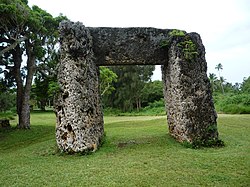This article needs additional citations for verification .(December 2009) |

A trilithon or trilith [1] is a structure consisting of two large vertical stones (posts) supporting a third stone set horizontally across the top (lintel). It is commonly used in the context of megalithic monuments. The most famous trilithons are those of Stonehenge in England.
Contents
The word trilithon is derived from Ancient Greek τρι- (tri-), meaning "three", and λίθος (líthos), meaning "stone", and was first used in its modern archaeological sense by William Stukeley.
Other famous trilithons include those found in the Megalithic temples of Malta (which like Stonehenge are a UNESCO World Heritage Site), the Osireion in Egypt, and the Haʻamonga ʻa Maui in Tonga, Polynesia. The term is also used to describe the groups of three stones in the Hunebed tombs of the Netherlands.

